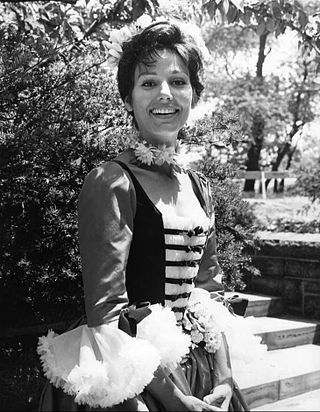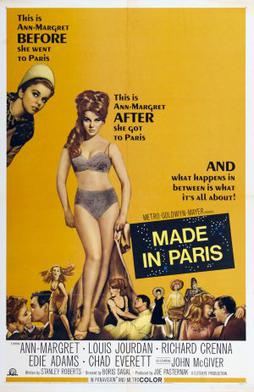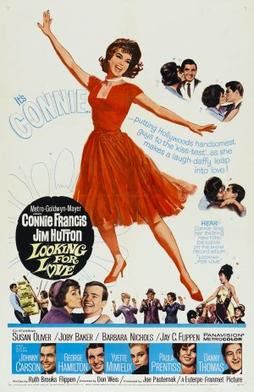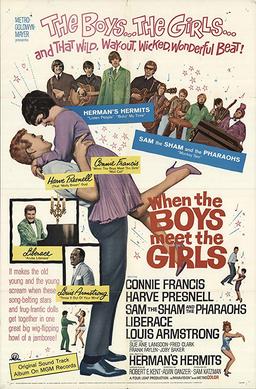
George Chakiris is an American actor and dancer. He is best known for his appearance in the 1961 film version of West Side Story as Bernardo, the leader of the Sharks gang, for which he won both the Academy Award for Best Supporting Actor and the Golden Globe Award for Best Supporting Actor – Motion Picture.

Richard Samuel Benjamin is an American actor and film director. He has starred in a number of well-known films, including Goodbye, Columbus (1969), Catch-22 (1970), Portnoy's Complaint (1972), Westworld (1973), The Last of Sheila (1973), and The Sunshine Boys (1975), for which he won a Golden Globe Award for Best Supporting Actor – Motion Picture. Benjamin was nominated for an Emmy Award for Best Actor in a Comedy Series for his performances in He & She (1968), opposite his wife Paula Prentiss.

Yvette Carmen Mimieux was an American film and television actress who was a major star of the 1960s and 1970s. Her breakout role was in The Time Machine (1960). She was nominated for three Golden Globe Awards during her acting career.

Paula Prentiss is an American actress. She is best known for her film roles in Where the Boys Are (1960), What's New Pussycat? (1965), Catch-22 (1970), The Parallax View (1974), and The Stepford Wives (1975).

Joseph Herman Pasternak was a Hungarian-American film producer in Hollywood. Pasternak spent the Hollywood "Golden Age" of musicals at Metro-Goldwyn-Mayer, producing many successful musicals with female singing stars like Deanna Durbin, Kathryn Grayson and Jane Powell, as well as swimmer/bathing beauty Esther Williams' films. He produced Judy Garland's final MGM film, Summer Stock, which was released in 1950, and some of Gene Kelly’s early breakthrough roles. Pasternak worked in the film industry for 45 years, from the later silent era until shortly past the end of the classical Hollywood cinema in the early 1960s.

Dana James Hutton, known as Jim Hutton, was an American actor in film and television best remembered for his role as Ellery Queen in the 1970s TV series of the same name, and his screen partnership with Paula Prentiss in four films, starting with Where the Boys Are. He is the father of actor Timothy Hutton.

Man's Favorite Sport? is a 1964 American screwball comedy film starring Rock Hudson and Paula Prentiss and directed and produced by Howard Hawks. Hawks intended the film to be an homage to his own 1938 screwball classic Bringing Up Baby with Katharine Hepburn and Cary Grant, and unsuccessfully tried to get the original stars to reprise their roles.

Joy in the Morning is a 1965 American romance film starring Richard Chamberlain and Yvette Mimieux and directed by Alex Segal. Adapted from the 1963 novel of the same name by Betty Smith, the film tells the story of a young newlywed couple, Carl and Annie Brown, who marry against their parents' wishes while Carl is still in law school and struggle to maintain their relationship.

The Wonderful World of the Brothers Grimm is a 1962 American fantasy film directed by Henry Levin and George Pal. The latter was the producer and also in charge of the stop motion animation. The film was one of the highest-grossing films of 1962. It won one Oscar and was nominated for three additional Academy Awards. The cast included several prominent actors—including Laurence Harvey, Karlheinz Böhm, Jim Backus, Barbara Eden and Buddy Hackett.

Light in the Piazza is a 1962 American romantic comedy drama film directed by Guy Green and starring Olivia de Havilland, Rossano Brazzi, Yvette Mimieux, George Hamilton, and Barry Sullivan. Based on the 1960 novel The Light in the Piazza by Elizabeth Spencer, the film is about a beautiful but mentally disabled young American woman traveling in Italy with her mother and the Italian man they meet during one leg of their trip.

Dark of the Sun is a 1968 British adventure war film starring Rod Taylor, Yvette Mimieux, Jim Brown, and Peter Carsten. The film, which was directed by Jack Cardiff, is based on Wilbur Smith's 1965 novel, The Dark of the Sun. The story about a band of mercenaries sent on a dangerous mission during the Congo Crisis was adapted into a screenplay by Ranald MacDougall. Critics condemned the film on its original release for its graphic scenes of violence and torture.

Made in Paris is a 1966 American romantic-comedy film starring Ann-Margret, Louis Jourdan, Richard Crenna, Edie Adams, and Chad Everett. The film was written by Stanley Roberts and directed by Boris Sagal.

Looking for Love is a 1964 romantic musical-comedy film starring popular singer Connie Francis.

Bachelor in Paradise is a 1961 American Metrocolor romantic comedy film starring Bob Hope and Lana Turner. Directed by Jack Arnold, it was written by Valentine Davies and Hal Kanter, based on a story by Vera Caspary.

Follow the Boys is a 1963 American comedy film directed by Richard Thorpe and starring Connie Francis, Paula Prentiss, and Janis Paige, released by Metro-Goldwyn-Mayer. Shot on location on the French and Italian Riviera, Follow the Boys was MGM's second film vehicle for top recording artist Francis following Where the Boys Are (1960). While Francis' role in the earlier film had been somewhat secondary, she had a distinctly central role in Follow the Boys playing Bonnie Pulaski, a newlywed traveling the Riviera.

When the Boys Meet the Girls is a 1965 American musical film directed by Alvin Ganzer and starring Connie Francis and Harve Presnell based on the musical Girl Crazy and a remake of MGM's 1943 film Girl Crazy.

Easy to Wed is a 1946 Technicolor American musical comedy film directed by Edward Buzzell, and starring Van Johnson, Esther Williams, Lucille Ball, and Keenan Wynn. The screenplay by Dorothy Kingsley is an adaptation of the screenplay of the 1936 film Libeled Lady by Maurine Dallas Watkins, Howard Emmett Rogers, and George Oppenheimer.

The Horizontal Lieutenant is a 1962 American romantic comedy war film, based on the 1961 novel The Bottletop Affair by Gordon Cotler who was a Japanese interpreter for US Army Intelligence during World War II. It is a military comedy about an unfortunate army intelligence lieutenant who finds himself isolated on a remote island army outpost during World War II. It stars Jim Hutton and Paula Prentiss and was directed by Richard Thorpe.

Your Cheatin' Heart is a 1964 American fictionalized biographical-musical directed by Gene Nelson and starring George Hamilton as country singer Hank Williams. It co-stars Susan Oliver and Red Buttons.

"Where the Boys Are" is a song written by Neil Sedaka and Howard Greenfield for, and first recorded by, Connie Francis as the title track of the 1960 movie by the same name in which she was co-starring.





















